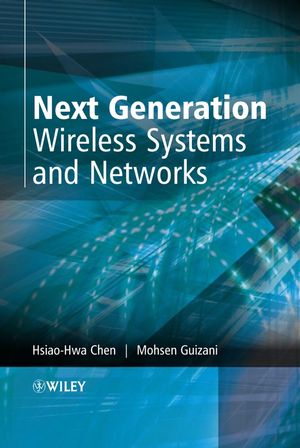Next Generation Wireless Systems and NetworksISBN: 978-0-470-02434-8
Hardcover
516 pages
June 2006
 This is a Print-on-Demand title. It will be printed specifically to fill your order. Please allow an additional 10-15 days delivery time. The book is not returnable.
|
||||||
About the Authors.
1. Introduction.
1.1 Part I: Background Knowledge.
1.2 Part II: 3GMobile Cellular Standards.
1.3 Part III: Wireless Networking.
1.4 Part IV: B3G and Emerging Wireless Technologies.
1.5 Suggestions in Using This Book.
2. Fundamentals of Wireless Communications.
2.1 Theory of Radio Communication Channels.
2.2 Spread Spectrum Techniques.
2.3 Multiple Access Technologies.
2.4 Multiple User Signal Processing.
2.5 OSI ReferenceModel.
2.6 Switching Techniques.
2.7 IP-Based Networking.
3. 3G Mobile Cellular Technologies.
3.1 CDMA2000.
3.2 WCDMA.
3.3 TD-SCDMA.
4. Wireless Data Networks.
4.1 IEEE 802.11 Standards for Wireless Networks.
4.2 IEEE 802.11a Supplement to 802.11 Standards.
4.3 IEEE 802.11 Security.
4.4 IEEE 802.15 WPAN Standards.
4.5 IEEE 802.16 WMAN Standards.
4.6 ETSI HIPERLAN and ETSI HIPERLAN/2 Standards.
4.7 MMAC by Japan.
4.8 Bluetooth Technologies.
5. All-IP Wireless Networking.
5.1 Some Notes on 1G/2G/3G/4G Terminology.
5.2 Mobile IP.
5.3 IPv6 versus IPv4 .
5.4 Mobile IPv6.
5.5 Wireless Application Protocol (WAP).
5.6 IP onMobile Ad Hoc Networks.
5.7 All-IP Routing Protocols.
6. Architecture of B3G Wireless Systems.
6.1 Spectrum Allocation andWireless Transmission Issues.
6.2 Integration ofWMAN/WLAN/WPAN andMobile Cellular.
6.3 High-Speed Data.
6.4 Multimode and Reconfigurable Platforms.
6.5 Ad hocMobile Networking.
6.6 Networking Plan Issues.
6.7 Satellite Systems in B3G Wireless.
6.8 Other Challenging Issues.
7. Multiple Access Technologies for B3G Wireless.
7.1 What B3GWireless Needs?.
7.2 A Feature Topic on B3GWireless.
7.3 Next-Generation CDMA Technologies.
7.4 Multicarrier CDMA Techniques.
7.5 OFDMTechniques.
7.6 Ultra-Wideband Technologies.
8. MIMO Systems.
8.1 SIMO,MISO, andMIMO Systems.
8.2 Spacial Diversity inMIMO Systems.
8.3 Spacial Multiplexing in MIMO Systems.
8.4 STBC-CDMA Systems.
8.5 Generic STBC-CDMA SystemModel.
8.6 Unitary Codes Based STBC-CDMA System.
8.7 Complementary Coded STBC-CDMA System.
8.8 Discussion and Summary.
9. Cognitive Radio Technology.
9.1 Why Cognitive Radio?.
9.2 History of Cognitive Radio.
9.3 What is Cognitive Radio?.
9.4 From SDR to Cognitive Radio.
9.5 Cognitive Radio for WPANs.
9.6 Cognitive Radio for WLANs.
9.7 Cognitive Radio for WMANs.
9.8 Cognitive Radio for WWANs.
9.9 Cognitive Radio for WRANs: IEEE 802.22.
9.10 Challenges to Implement Cognitive Radio.
9.11 Cognitive Radio Products and Applications.
10. E-UTRAN: 3GPP’s Evolutional Path to 4G.
10.1 3GPP TSG for E-UTRAN.
10.2 Origin of E-UTRAN.
10.3 General Features of E-UTRAN.
10.4 E-UTRAN Study Items.
10.5 E-UTRAN TSGWork Plan.
10.6 E-UTRAN Radio Interface Protocols.
10.7 E-UTRAN Physical Layer Aspects.
10.8 Summary.
A: Orthogonal Complementary Codes (PG = 8 ∼ 512).
B: MAI in Asynchronous Flat Fading UWB Channel.
C: MI in Asynchronous Modified S-V UWB Channel.
D: Proof of Equation (8.44).
E: Properties of Orthogonal Complementary Codes.
F: Proof of Equation (8.66).
Bibliography.
Index.



